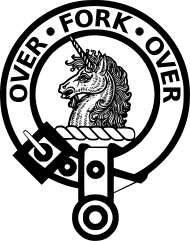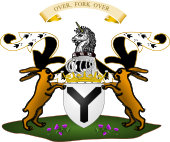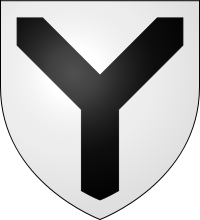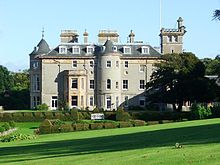- Clan Cunningham
-
Cunningham Crest badge 
Motto: "Over Fork Over" Profile Chief Cunningham has no chief, and is an armigerous clan 
Arms of the last Chief of Cunningham Last Chief: John Cunningham, 15th Earl of Glencairn Earl of Glencairn Died: 1796 Historic seat Finlaystone Castle Allied clans Clan Graham Rival clans Clan Montgomery Clan Cunningham is a Scottish clan. The clan does not currently have a chief, therefore it is considered an Armigerous clan by the Standing Council of Scottish Chiefs, though recently two contenders for the chiefship have emerged. Legal opinion is currently being sought and the best claimant will then petition Lord Lyon for recognition.
Contents
History
Origins
Traditionally, in 1059, King Malcolm rewarded Malcolm, son of Friskin with the Thanedom of Cunninghame. Cunninghame is the northern part of Ayrshire.[1]
The first known Cunningham was Warnebald Cunningham and then his son Robertus Cunningham. Warnebald was granted the lands of Cunninghame by Hugh de Morville in around 1115. Robertus received the lands of Cunningham between the years 1160 and 1180. The Clan Cunningham was well settled in their lands and the parish of Kilmaurs by the late 13th century. The Clan Cunningham fought for King Alexander III of Scotland at the Battle of Largs in 1263. As a result, for this service Hervy de Cunningham, the son of the Laird of Cunningham received a charter from King Alexander III of Scotland confirming all of their lands.
Wars of Scottish Independence
During the Wars of Scottish Independence the Clan Cunningham supported King Robert the Bruce of Scotland. Although their name previously appears on the Ragman Roll in 1296 where they swear allegiance to King Edward I of England. As a reward for supporting King Robert the Bruce of Scotland the Clan Cunningham were given the lands of Lamburgton to add to their existing lands.
Later during the 14th century Sir William Cunningham of Kilmaurs was one of the Scottish noblemen who were offered to the English as a substitute for the captured King David II of Scotland. His son William married Margaret, the elder daughter and co-heiress of Sir Robert Denniston and through her acquired substantial lands, including Finlaystone in Refrewshire and Glencairn in Dumfriesshire.
15th and 16th century and clan conflicts
In 1421 Henry Cunningham the third son of William Cunningham led the Cunninghams at the Battle of Beauge.
Sir Williams grandson Alexander Cunningham was made Lord Kilmaurs in 1462 and later the first Earl of Glencairn. During the revolt against King James III of Scotland Alexander brought a substantial force to support the King and defeated the rebels at the Battle of Blackness.
In 1488 the Clan Montgomery burned down the Clan Cunningham's Kerelaw Castle.[2] This was part of a century-long feud that had apparently started when the office of Baillie in Cuninghame, held by the Cunninghams, was awarded to the son of Lord Montgomerie on 31 January 1448-9.[2] The two clans had been on opposing sides at the Battle of Sauchieburn, with Hugh Montgomery among the victorious rebels and Alexander Cunningham, 1st Earl of Glencairn slain with the defeated James III. A longstanding rivalry (principally over the Bailieship of Cunninghame) was now a vendetta.
During the 16th century the long-running feud continued. Edward Cunningham of Auchenharvie was slain in 1526 and Archibald Cunningham of Waterstoun in 1528;[3] Eglinton Castle was burned down by the Cunninghams in the same year. In April 1586, Hugh Montgomery, 4th Earl of Eglinton, aged twenty-four, was travelling to Stirling to join the Court having been commanded to attend by the King, accompanied only by a few domestic servants. He stopped at Lainshaw Castle to dine with his close relative, a Montgomery, the Lord of Lainshaw, whose Lady was a Margaret Cunningham of Aiket Castle, with sisters married to John Cunningham of Corsehill and David Cunninghame of Robertland.[4] It seems that a plot to kill the Earl had been organised and the Lady, or some say a servant girl who was also a Cunningham,[3] climbed to the battlements after the meal to hang out a white table napkin and thereby sprung the trap. Thirty Cunninghames attacked the Earl as he crossed Annick Ford and cut his servants to pieces; the Earl himself was dispatched with a single shot from the pistol of John Cunningham of Clonbeith Castle. His horse carried his dead body along the side of the river, still known as the 'Weeping', 'Mourning' or 'Widows' path. A wave of bloody revenge swept over Cunninghame and elsewhere. Cunningham relatives, friends and supporters were killed without mercy. Aiket was killed near his home; Robertland and Corsehill escaped to Denmark. Clonbeith was traced to a house in Hamilton, possibly Hamilton Palace[5] and hacked to pieces by Robert Montgomery and John Pollock. Robert also killed the Earl of Glencairn's brother the Commendator of Kilwinning Abbey, Alexander of Montgreenan, thought to have instigated Hugh's murder. He rode to Montgreenan and shot the Commendator at his own gate.[6]
The government of King James VI of Scotland eventually managed to make the chiefs of the two clans shake hands. In 1661 Lord High Chancellor William Cunningham, 9th Earl of Glencairn, married Margaret Montgomery, daughter of Alexander, 6th Earl of Eglinton, drawing a line under the feud.
In 1526 Cuthbert the 3rd Earl of Glencairn was wounded in a failed attempt to rescue King James V of Scotland from the Clan Douglas at the Battle of Linlithgow. In 1542 William Cunningham, 4th Earl of Glencairn led the clan against the English at the Battle of Solway Moss where he was captured. He was released for a ransom of £1000.
The fifth Earl of Glecairn also called Alexander Cunningham was a Protestant reformer. He was also a patron of the reformer John Knox. In 1556 John Knox performed the first Protestant Reformed Communion service on Easter Sunday under a Yew tree at Finlaystone for the 5th Earl. In 1568 Alexander Cunningham the 5th Earl of Glencairn led the clan at the Battle of Langside near Glasgow.
The Clan Cunningham fought against Mary, Queen of Scots, at the Battle of Carberry Hill where she was defeated. The Chief of the Clan Cunningham was one of the commanders at this battle. Alexander Cunningham is also reported to have ordered the destruction of the Chapel Royal at Holyrood.
17th century and Civil War
In 1643 Chief William Cunningham led the clan at the Battle of Kilsyth to rescue the King from Oliver Cromwell but he was defeated.
During the Civil War, the Clan Cunningham supported King Charles II. Chief William Cunningham, 9th Earl of Glencairn, commanded the Royalist rising from 1653 to 1654 and raised a force of over 5000 in 1653 to oppose General Monck, who was the governor of Scotland. In August of the same year, William Cunningham went to Lochearn in Perthshire where he met with some of the Chiefs of the Highland clans. With a body of men he then took possession of Elgin in 1654.
18th century and Jacobite uprisings
During the Jacobite Uprisings the Clan Cunningham supported the British government. The Cunninghams fought at the Battle of Culloden in 1746 where Captain Cunningham commanded the British artillery which fired Grapeshot at the advancing Jacobites.
Modern history
Scottish descendants around the world have formed ancestral family clubs, known as clan associations, to celebrate their Scottish heritage. While most of these clubs interact with their main Clans in Scotland, they hold no authority in the Government of Scotland or in the official operations of the Clan itself (outside of the express consent of a Clan's ruling Chief, which is extremely rare). In the past century, during the dormancy of the titles of the Clan Chief, several Cunningham associations have formed in Canada, Australia and particularly in the United States. There has recently been a dispute between the two Cunningham groups in North America - Clan Cunningham Society of America [CCSOA], and Clan Cunningham International [CCI]; the latter of which was chosen to host the Cunningham tent at the 2009 International Gathering of Scottish Clans in Scotland - known as The Gathering 2009. Today, Clan Cunningham International is widely recognized as the predominant organization of the two groups.
Castles
Clan Cunningham castles include:
- Finlaystone Castle in Kilmacolm, Renfrewshire was the ancestral seat of the Clan Cunningham Chief, Earl of Glencairn between 1401 and 1796 and then passed to the Cunninghame-Grahams of Gartmore until 1863 when it was sold.
- Château de Cherveux in France was built in 1470 by Robert de Conyngham during the Auld Alliance after he served as the Captain of the King's Bodyguard for both French Kings Charles VII and Louis XI. Owned by François and Marie-Thérèse Redien, it is open to the public.
- Kerelaw Castle was owned by the Clan Cunningham from the 15th century.
- Auchenharvie Castle owned by the Cunninghams from at least the 17th century.
- Dumbarton Castle was where four Cunninghams served as governors from as early as the 16th century. Inside is a coat of arms displaying the governors that served in the castle, spanning eight centuries from 1264 to 1996. The first three Cunningham coat of arms displayed are: 1571; John Cunningham the 6th Drumquhassil, 1692; John Cunningham the 11th Earl of Glencairn and 1714; Colonel William Cunningham the 12th earl of Glencairn. There was also a fourth Cunningham governor in the 20th century: 1955; Admiral Sir Angus Cunninghame Graham the 16th of Gartmore and 20th of Ardoch, whose dress uniform is on public display in the Governor's House.
- Corsehill Castle, Stewarton.
- Cunninghamhead Castle.
- Robertland Castle, Stewarton.
- Aiket Castle, Dunlop.
- Thorntoun Castle, Springside.
- Lainshaw Castle, Stewarton.
- Clonbeith Castle, Auchentiber.
- Montgreenan Castle, Auchentiber.
- Glengarnock Castle is a ruined keep, located on the River Garnock about 2 miles north of Kilbirnie.
See also
- Cunningham - a list of famous Cunninghams
- Lambroughton - The origins of the Cunninghames.
- Cunninghamhead - Cunninghame family history.
- Thorntoun house and estate - Cunninghame family history.
- Corsehill - Cunninghame family history.
- Cunninghamhead Estate - Cunninghame family history.
- Cunninghamhead, Perceton and Annick Lodge- Cunninghame family history.
Notes and references
- ^ "The Lordship & Barony of Kilmarnock". Baron of Kilmarnock. http://www.kilmarnock.com/cunningham.html.
- ^ a b Paterson, James (1866). History of the counties of Ayr and Wigton. J. Stillie. p. 23. http://books.google.com/?id=pVwLAAAAYAAJ&pg=PA23
- ^ a b Robertson, William (1889). "Historical Tales of Ayrshire". Pub. Glasgow & London.
- ^ Dobie, James D. (ed Dobie, J.S.) (1876). Cunninghame, Topographized by Timothy Pont 1604–1608, with continuations and illustrative notices. Pub. John Tweed, Glasgow.
- ^ Ker, Rev. William Lee (1900) Kilwinnning. Pub. A.W.Cross, Kilwinning. .P 153.
- ^ Skelmorlie - Walter Smart History(1968).
External links
- Clan Cunningham International Clan Cunningham International
- www.clancunningham.us Clan Cunningham Society of America, Inc.
- www.ccusane.org - Clan Cunningham International - USA Northeast Region
Scottish clans Clans with chiefs Agnew · Anstruther · Arbuthnott · Arthur · Bannerman · Barclay · Borthwick · Boyd · Boyle · Brodie · Broun · Bruce · Buchan · Burnett · Cameron · Campbell · Carmichael · Carnegie · Cathcart · Charteris · Chattan · Chisholm · Cochrane · Colquhoun · Colville · Cranstoun · Crichton · Cumming · Darroch · Davidson · Dewar · Drummond · Dunbar · Dundas · Durie · Elliot · Elphinstone · Erskine · Farquharson · Fergusson · Forbes · Forsyth · Fraser · Fraser of Lovat · Gayre · Gordon · Graham · Grant · Gregor · Grierson · Guthrie · Haig · Haldane · Hamilton · Hannay · Hay · Henderson · Home · Hope · Hunter · Irvine · Jardine · Johnstone · Keith · Kennedy · Kerr · Kincaid · Lamont · Leask · Lennox · Leslie · Lindsay · Lockhart · Lumsden · Lyon · MacAlister · MacBain · MacDonald · Macdonald of Clanranald · MacDonald of Keppoch · Macdonald of Sleat · MacDonell of Glengarry · MacDougall · Macdowall · MacIntyre · Mackay · Mackenzie · Mackinnon · Mackintosh · Maclachlan · Maclaine of Lochbuie · MacLaren · MacLea (Livingstone) · Maclean · MacLennan · MacLeod · MacLeod of Lewis · MacMillan · Macnab · Macnaghten · MacNeacail · MacNeil · Macpherson · MacTavish · MacThomas · Maitland · Makgill · Malcolm (MacCallum) · Mar · Marjoribanks · Matheson · Menzies · Moffat · Moncreiffe · Montgomery · Morrison · Munro · Murray · Napier · Nesbitt · Nicolson · Ogilvy · Oliphant · Primrose · Ramsay · Rattray · Riddell · Robertson · Rollo · Rose · Ross · Ruthven · Sandilands · Scott · Scrymgeour · Sempill · Shaw · Sinclair · Skene · Spens · Stirling · Strange · Stuart of Bute · Sutherland · Swinton · Trotter · Urquhart · Wallace · Wedderburn · Wemyss · Wood ·
Armigerous clans Abercromby · Abernethy · Adair · Adam · Aikenhead · Ainslie · Aiton · Allardice · Anderson · Armstrong · Arnott · Auchinleck · Baillie · Baird · Balfour · Bannatyne · Baxter · Bell · Belshes · Bethune · Beveridge · Binning · Bissett · Blackadder · Blackstock · Blair · Blane · Blyth · Boswell · Brisbane · Buchanan · Butter · Byres · Cairns · Calder · Caldwell · Callender · Campbell of Breadalbane · Campbell of Cawdor · Carruthers · Cheyne · Chalmers · Clelland · Clephane · Cockburn · Congilton · Craig · Crawford · Crosbie · Cunningham · Dalmahoy · Dalrymple · Dalzell · Dennistoun · Don · Douglas · Duncan · Dunlop · Edmonstone · Fairlie · Falconer · Fenton · Fleming · Fletcher · Forrester · Fotheringham · Fullarton · Galbraith · Galloway · Gardyne · Gartshore · Ged · Gibsone · Gladstains · Glas · Glen · Glendinning · Gray · Gunn · Haliburton · Halkerston · Halket · Hepburn · Heron · Herries · Hogg · Hopkirk · Horsburgh · Houston · Hutton · Inglis · Innes · Kelly · Kinloch · Kinnaird · Kinnear · Kinninmont · Kirkcaldy · Kirkpatrick · Laing · Lammie · Langlands · Learmonth · Little · Logan · Logie · Lundin · Lyle · MacAulay · Macbrayne · MacDuff · MacEwen · MacFarlane · Macfie · Macgillivray · MacInnes · MacIver · Mackie · MacLellan · Macquarrie · Macqueen · Macrae · Masterton · Maule · Maxton · Maxwell · McCorquodale · McCulloch · McKerrell · Meldrum · Melville · Mercer · Middleton · Moncur · Monteith · Monypenny · Mouat · Moubray · Mow · Muir · Murray of Atholl · Nairn · Nevoy · Newlands · Newton · Norvel · Ochterlony · Orrock · Paisley · Paterson · Pennycook · Pentland · Peter · Pitblado · Pitcairn · Pollock · Polwarth · Porterfield · Preston · Pringle · Purves · Rait · Ralston · Renton · Roberton · Rossie · Russell · Rutherford · Schaw · Seton · Skirving · Somerville · Spalding · Spottiswood · Stewart · Stewart of Appin · Strachan · Straiton · Strange · Sydserf · Symmers · Tailyour · Tait · Tennant · Troup · Turnbull · Tweedie · Udny · Vans · Walkinshaw · Wardlaw · Watson · Wauchope · Weir · Whitefoord · Whitelaw · Wishart · Young
Culture and society Scotland · Clan chief · Septs · Clan badge · Clan crest · Clan battles · Tartan · Bagpipes · Clearances · Kilt · Manrent · The Highlands · Battle of Culloden · Highland games · Border Reivers · Scottish heraldry · Scottish surnames
Categories:- Scottish clans
- Armigerous clans
Wikimedia Foundation. 2010.


